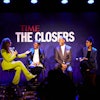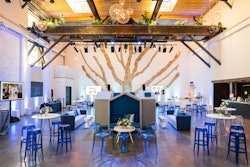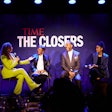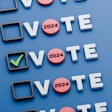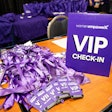
Last March, Microsoft research showed that more than 50% of hybrid and remote employees feel lonelier at work than they did pre-pandemic, when they went into an office every day. The report adds that employees who develop deeper connections with their colleagues report higher satisfaction, productivity, and creativity.
So, what does this have to do with events? In our new remote-first normal, your potential event attendees may be craving connection more than ever—and the value of events and meetings has never been more clear. This doesn’t just apply to internal meetings, either; employees are eager for the inspiration and education that comes with industry conferences, while consumers want to experience memorable brand activations and philanthropists are eager for nonprofit events that demonstrate the power of their donations.
On the flip side, though, is the looming recession and lingering supply chain issues, which can drive up costs. While American Express’ 2023 Global Meetings & Events Forecast does show meeting spend increasing by 3.1% this year, there were still 35% of respondents saying that their meeting budgets are staying the same—or even decreasing.
Whether you’re an internal or third-party planner, you’ve likely dealt with a C-suite that’s hesitant to spend money on in-person events, meetings, team-building exercises, or group travel. Here are some tips to give them that extra push...
1. Be very clear about what this event would accomplish.
Ben Maddock, event director of Events Made Simple, notes that having a clear understanding of your objectives is crucial. “Determine if the event is intended to be a reward for good performance, to integrate new team members or provide training, and clearly outline the event's goals before presenting them to the C-suite,” he says. “This will increase your chances of success by showing how the event aligns with the company's values and strategies. For instance, if the company aims to attract and retain top talent, explain how the event will support this objective.”
2. Lean into data and past success.
Don't forget: Executives are busy, and may have short attention spans. Prepare a data-driven presentation that's clear and concise, and lean into tangibles rather than emotions. Focus on the ROI, advises Melissa Park, event producer for Melissa Park Events. “It’s a much easier conversation when the organization has held in-person events in the past so we can use their data, including revenue via sales, that can be attributed to events to back up our recommendation,” she adds. “To help drive this argument home, we recap the program they previously delivered and present a fresh concept highlighting how our recommended changes (or complete event redesign) will help them achieve their business goals.”
Maddock also likes giving examples of past successes. “If your company has previously allocated a budget for team-building events, incentives, or face-to-face meetings, you can use this to your advantage when making your case for future investments. Utilize feedback and data from past events to demonstrate their value and impact,” he says, adding that this can mean referencing employee surveys, metrics on team retention rates, or examples of improvements in team dynamics and productivity.
“This information can be used to show the effectiveness of past events and make a more compelling case for future investments,” Maddock continues. “If you are not aware of the company's history of investing in team-building events and conferences, reach out to the HR department for information about events held by other departments.”
3. But also don’t get too bogged down with hard-to-measure specifics.
With some events, though—particularly on the experiential marketing side—it can be tricky to measure the metrics. Lauren Austin, chief creative officer of creative agency MKG, finds today's C-suite leaders generally understand that "creating experiences where people can have memorable and emotional interactions with a brand is how you build brand love."
But the challenge Austin is facing today with CMOs is how to measure the ROI of something like an experiential marketing campaign. "C-suite leadership loves data, and they often need to show their shareholders or stakeholders that their strategies are working. But experiential is tricky to measure, and most brands are using the same metrics that they use for media to evaluate an experience. Our job at MKG, with every project, is to prove that each experience is so much more than just an ‘impression.' We believe that action speaks louder than an ad, and while that is sometimes immeasurable, the wide-ranging results we share with our C-suite partners can often speak for themselves.”
4. Be prepared to discuss the value of in-person versus virtual.
Lee Gimpel, president of Better Meetings, cautions that many executives these days will ask why they need to invest in hosting or sending team members to an in-person meeting, when the same information is available virtually. So be prepared to explain the value of in-person connections, he suggests.
“Surveys and our own practical experience tell us that a huge part of the value people get when attending events comes from meeting other people,” he notes. “That may be connecting with an existing customer, finding a new client, engaging with a new partner, or being able to do a deep dive and answer really specific questions with someone who has special expertise. In other words, while watching someone do a presentation at an event may have value, those presentations are rarely the home run that gets people excited about attending an event.”
Gimpel’s strategy for executives inquiring about ROI is to “ask them how many sales or how many partnerships came out of all of the online events that employees have attended versus the in-person events. That answer might be both very telling and very compelling."
5. Be ready with a clear breakdown of the costs.
“A common error that can occur when trying to secure funding for an event is not having a clear understanding of the costs,” adds Maddock. “It can be disheartening to invest time and resources into obtaining a budget, only to later realize it is not sufficient." To prevent this, he suggests thoroughly researching the cost of the event before approaching the executive or finance teams. "Event organizers and venues can provide estimates to help plan your budget proposal. By having a clear understanding of the expenses, you can present a more accurate and convincing case for funding.”
Josh Wood, founder and CEO of event production company JWP, who often works with C-suite executives on large-scale events with major fundraising components, agrees. "To best ensure that a CEO or CMO has all of the information they need to sign off on an event, we always enter meetings or proposal discussions with a clear revenue plan and/or cost-benefit analysis, so we can achieve our creative production goals with the full trust and support of our clients," he explains.
Wood also stresses the importance of staying flexible. "If a client or C-suite executive ever expresses skepticism around an in-person event or the nature of the planning, we are always prepared to work with them and, based on our experience, illustrate precisely why and how the right in-person event, with the proper ambiance and components, is always vital for communicating directly to our guests and our donors," he notes. "We’re in the business of ensuring that our clients are seen in the best light, specifically when it pertains to supporting noble causes, and part of the work is ensuring that they can see that as well and understand the value."
6. Study up on the value of face-to-face connection.
Heather Larson, president and CEO of the convention and visitors bureau Meet Chicago Northwest, points out a recent study that stated 89% of Harvard Business Review readers believe that meetings held in person provide value beyond the meeting itself.
“Business leaders and executives know that they have gained positively from meeting in person in their careers,” she explains. “The collaboration and ingenuity that transpires at meetings and events foster a level of creativity that is brought back to the employee’s organization. We’ve all felt that energy when we come back from a really great conference with a long list of ideas ready to be implemented. A company that is willing to train its employees by allowing them to attend professional conferences, or putting on conferences themselves, will be a more successful organization in the future.”
Larson adds that “we had our George Bailey moment with meetings and conventions,” referencing the protagonist of It's a Wonderful Life. “We lived in a world without folks being able to come together to share ideas and experiences. … Much of the learning that comes from our professional meetings and events comes from the side conversations at the table and during coffee breaks. Asking our peers one on one, ‘How are you handling this situation’ or ‘What would you do?’—these are invaluable conversations and connections that transcend the presentations on the stage.”



